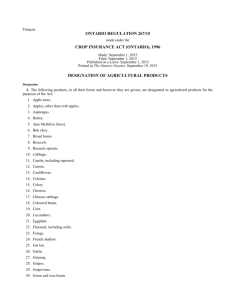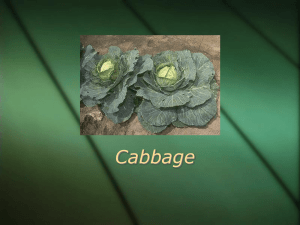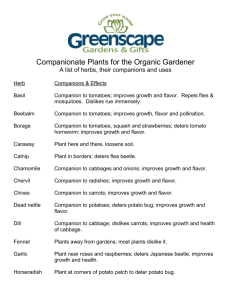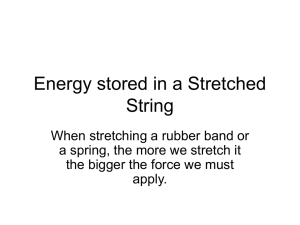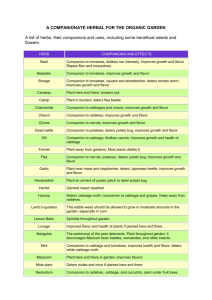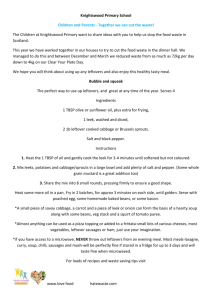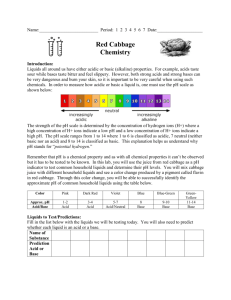doc
advertisement
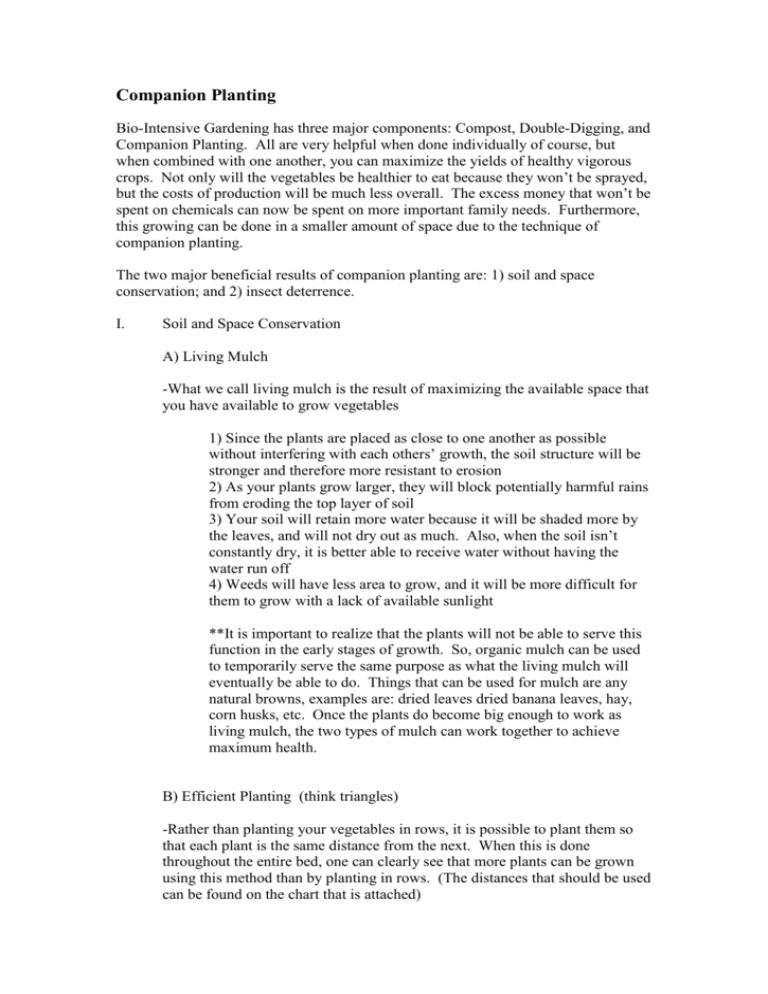
Companion Planting Bio-Intensive Gardening has three major components: Compost, Double-Digging, and Companion Planting. All are very helpful when done individually of course, but when combined with one another, you can maximize the yields of healthy vigorous crops. Not only will the vegetables be healthier to eat because they won’t be sprayed, but the costs of production will be much less overall. The excess money that won’t be spent on chemicals can now be spent on more important family needs. Furthermore, this growing can be done in a smaller amount of space due to the technique of companion planting. The two major beneficial results of companion planting are: 1) soil and space conservation; and 2) insect deterrence. I. Soil and Space Conservation A) Living Mulch -What we call living mulch is the result of maximizing the available space that you have available to grow vegetables 1) Since the plants are placed as close to one another as possible without interfering with each others’ growth, the soil structure will be stronger and therefore more resistant to erosion 2) As your plants grow larger, they will block potentially harmful rains from eroding the top layer of soil 3) Your soil will retain more water because it will be shaded more by the leaves, and will not dry out as much. Also, when the soil isn’t constantly dry, it is better able to receive water without having the water run off 4) Weeds will have less area to grow, and it will be more difficult for them to grow with a lack of available sunlight **It is important to realize that the plants will not be able to serve this function in the early stages of growth. So, organic mulch can be used to temporarily serve the same purpose as what the living mulch will eventually be able to do. Things that can be used for mulch are any natural browns, examples are: dried leaves dried banana leaves, hay, corn husks, etc. Once the plants do become big enough to work as living mulch, the two types of mulch can work together to achieve maximum health. B) Efficient Planting (think triangles) -Rather than planting your vegetables in rows, it is possible to plant them so that each plant is the same distance from the next. When this is done throughout the entire bed, one can clearly see that more plants can be grown using this method than by planting in rows. (The distances that should be used can be found on the chart that is attached) C) Crop Rotation (Leaf – Fruit – Root – Legume) -Different plants interact in different ways with the nutrients in the soil. Some take a small amount of nutrients and they are called Light Feeders (LF), some take a large amount of nutrients from the soil and these are hard Heavy Feeders (HF), and some plants give nutrients back to soil and they are called Heavy Givers (HG). One can’t expect to have healthy soil every year when a Heavy Feeder is planted year after year into the same soil. Plants need to be rotated so that the soil doesn’t become totally depleted of nutrients. So, every one or two seasons, the plants that you have been planting in one area should be changed. (Refer to the charts on the following pages that label each plant as LF, HF, or HG) Breaking disease and insect cycles through crop rotation is critical for garden success. Follow this simple leaf-fruit-root-legume cropping pattern as much as possible to encourage healthy fertility and less insect and disease. II. Insect Deterrents A) Crop Variation -The main objective here is to make it more difficult for insects and disease to attack your plants. 1) Each plant releases different chemicals into the soil, which can sometimes be very good for other plants, these are called companions. However, plants can also release chemicals that can be bad for one another, and these are called antagonists. This is why it is important to plant vegetables next to one another that will help both to grow stronger. As the plants are strengthened, they are less susceptible to pests and disease. (There is a list of companions and antagonists on the following pages) 2) Crop variation is important because your crops will be less susceptible to large disastrous invasions by a pest. Insects can more easily attack one large field of one type of crop than one that has many different types. Therefore, variety in each bed is a type of natural protection. B) Use of Beneficials -The beneficials are usually flowers or herbs that give you a natural way to make your plants more resistant to insects and to make your garden look nice all at the same time -The beneficials attract “good” insects that eat the “bad” one’s: predator vs. prey; instead of killing all the insects with pesticides, allow the “good” one’s to help your plants TRANSPLANTING Growing seedbeds in order to transplant is beneficial for a number of reasons. 1) You can select which seedlings you want to transplant. This means that you can take the healthiest seedlings rather than planting a seed directly into your bed that might not germinate at all. 2) Seedbeds require much less water than do crop beds. A great deal of water and time can be saved by using this technique because there is much less space to water. 3) You can control how the plant will grow. When you transplant, if you place the plant in the ground up to its’ first leaves than it will insure a strong stem for the plant. If done improperly than the plant will develop a week stem (see picture), and the plant won’t grow to its’ full potential. 4) If transplanting is done in the evening, it is best because the seedlings have an opportunity to adjust over night when the sun isn’t out. This will prevent excessive wilting of the plant and will allow greater opportunity to grow. 5) If seedlings are attacked by a “pest” you can choose not to plant those plants in the growing bed so that the plants don’t introduce the “pest” to the other plants Spacing Distances for Plants Plant African Eggplant Amaranth (for greens) Asparagus Basil Beans Beets Broccoli Chin. Cabbage Cabbage Carrots Comfrey, Russian Cauliflower Swiss Chard Collards Corn Cucumbers Eggplant Garlic Horseradish Kale Leeks Lettuce, Head Lettuce, Leaf Mustard Nightshade Okra Distance (Spacing) 60cm 10cm 30 cm 15cm 17cm 10cm 35cm 25cm 35cm 7cm 30cm 35cm 20cm 28cm 40cm 25cm 44cm 10cm 28cm 35cm 15cm 30cm 22cm 15cm 20cm 15cm HG, HF, or LF HF HF HF HF HG LF HF HF HF LF HF HF HF HF HF HF HF LF LF HF LF HF HF HF HF HF Onions Parsley Peas Peppers, Hot Peppers, Sweet Potato, Irish Potato, Sweet Pumpkin Radishes Shallots Soybeans Spinach Strawberries Swiss Chard Sunflower Tomatoes Tomatoes, Cherry Turnips Watermelon Zucchini 10cm 10cm 10cm 30cm 30cm 22cm (15cm depth) 22cm (15cm depth) 50cm 5cm 10cm 15cm 15cm 30cm 20cm 45cm 40cm 40cm 10cm 50cm 45cm LF HF HG HF HF LF LF HF LF HF HG HF HF HF HF HF HF LF HF HF A List of Common Vegetables, Their Companions and Antagonists Companions Tomatoes, Parsley, Basil Antagonists Asparagus Beans Almost all vegetables Onions, garlic Beets Onions Some beans Cabbage Family Aromatic herbs, potatoes, (cabbage, cauliflower, kale, dill, sage, mint, rosemary, beans nightshade, broccoli) beets, onions Strawberries, tomatoes, some Carrots Peas, lettuce, chives, Onions, leeks, rosemary, Sage, tomatoes Dill Chives Carrots Peas, beans Corn Potatoes, peas, beans, Cauliflower, cabbage Cucumbers Beans, corn, peas, radishes, Sunflowers Eggplant Leeks Beans Onions, carrots Potatoes, aromatic herbs Lettuce Carrots (very good with lettuce And radishes), strawberries, Cucumbers Onions (and garlic) Beets, strawberries, tomatoes, Lettuce, parsley Parsley Tomatoes, asparagus Peas Most vegetables Onions, garlic, Potatoes Potatoes Beans, corn, cabbage, Horseradish, marigolds, Eggplant Pumpkins, squash, cucumbers, sunflowers, Pumpkins Corn Potatoes Radishes Peas, nasturtiums, lettuce, Cucumbers Soybeans Grows with anything Spinach Strawberries Squash Nasturtiums, corn Strawberries Beans, spinach, lettuce Cabbage Tomatoes Chives, onions, parsley, Asparagus, marigolds, Nasturtiums, carrots Potatoes, fennel, cabbage Peas, beans tomatoes, Herbs and Flowers : deter insects and strengthen soil. Basil Companion to tomatoes, dislikes rue intensely. Improves growth and flavor. Repels flies and mosquitoes. Chives Companion to carrots; improves growth and flavor. Dill Companion to cabbage; dislikes carrots; improves growth and health of cabbage Fennel Plant away from gardens. Most plants dislike it. Garlic Deters beetles. Hyssop Deters cabbage moth; companion to cabbage. Marigolds The workhorse of the pest deterrents. Plant throughout garden; they discourage many insects including beetles and nematodes. Mint Companion to cabbage, and tomatoes; improves health and flavor; deters white cabbage moth. Nasturtium Companion to radishes and cabbage; plant under fruit trees. Deters aphids, squash bugs, stripped pumpkin beetle. Improves growth and flavor. Eat the leaves as well as the flowers. Petunia Protects beans. Calendula Companion to tomatoes, but plant elsewhere in the garden too. Deters asparagus beetle, tomato worm, and general garden pests. Rosemary Companion to cabbage, beans, carrots, and sage; deters cabbage moth, bean beetles, and carrot fly Sage Plant with rosemary, cabbage, and carrots; keep away from cucumbers. Deters cabbage moth, carrot fly. Tarragon Good throughout garden. Wild Morning Glory Grow with corn.
